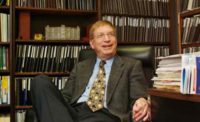Engineer and professor emeritus Alan G. Davenport, a pioneer in wind engineering for buildings and bridges, died on July 19 at age 76 after a long struggle with Parkinson’s disease.
Models for many of the world’s tallest and longest structures ended up in the hands and wind tunnel of Davenport, one of the first to use wind tunnels in the design of structures. An engineering professor at the University of Western Ontario, he founded its renowned Boundary Layer Wind Tunnel Laboratory in 1965. He consulted on the designs of New York City’s World Trade Center, Chicago’s Sears Tower, Toronto’s CN Tower, France’s Normandy Bridge and many others. For Canada, he developed the world’s first statistically based, seismic-hazard zoning map.

“He would pack a model in a briefcase and have it by his side for an air journey,” says Peter King, managing director of the Alan G. Davenport Wind Engineering Group at the University of Western Ontario’s BLWTL, in London. “That did cause a number of up-raised eyebrows, even in those days,” he adds.
Davenport, named one of the “Top People of the Past 125 Years” by ENR in 1999, focused on preventing catastrophic losses from natural disasters. He was driven to seek out practical solutions to natural disasters and inspired his colleagues and students to solve problems in a broad range of disciplines, not only in wind engineering but also in seismicity, wind/wave interaction, risk analysis and numerous other fields, says King.
Davenport’s first wind tunnel project was carried out for two record-height buildings, the WTC’s 110-story twin towers. In 1964, he led the historic tests at a Colorado State University laboratory, typically used for air-pollution studies. The tests drew WTC architect Minoru Yamasaki; the Port Authority of New York’s Malcolm Levy, representing the owner; WTC structural engineers John Skilling and Leslie E. Robertson; and CSU wind engineer Jack Cermak.

DAVENPORT
Davenport was born in 1932 in Madras, India. He completed engineering studies at Cambridge University and the University of Toronto before flying with the Canadian Navy. He later joined the National Research Council, where he developed his interest in wind loads. In 1961, he earned a Ph.D. at the University of Bristol. He then joined Western’s faculty. One of his last projects was to help found the Institute for Catastrophic Loss Reduction, which develops and disseminates disaster-prevention knowledge.

